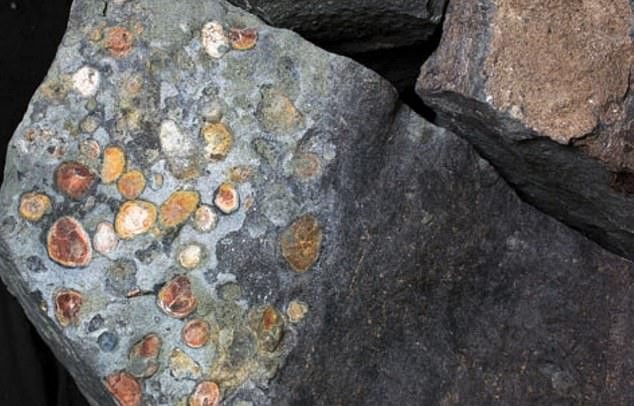An 18-foot armor-plated dinosaur that weighed one-and-a-half ton was discovered in a well-preserved state in Canada. This 110-million-year-old dinosaur was found to be a picky eater and within its guts is the ‘exceptionally preserved’ last meal.

(Photo : The Royal Society) This is a close up photo of the gut from the dinosaur and shows the remains of its food – as seen in the colourful dots in the grey mass

(Photo : The Royal Society) This is an example of one of the plans found inside the guts of the dinosaur. The huge armoured beast weighed up to one-and-a-half tons when it was alive, and despite its bulk, it was a picky eater, according to the team behind the study
The fossilized plant remains of the bone-plated Borealopelta markmitchell gives insight into the animal’s diet which prefers fern leaves and a variety of plants. The huge armored beast was found in a mine near Fort McMurray, northern Alberta, Canada.
Exceptionally Preserved Guts
According to Science Alert, this thorny, 2,800 pounds nodosaur was unearthed in 2011, and first described in 2017, contains the best-preserved dinosaur guts ever found in the history. Five years of work exposed the dinosaur within the marine rock, and the soccer ball-sized mass inside its stomach gave an insight into what large, plant-eating dinosaurs once munched on all those millennia ago.
Along with the plant fossils, scientists also found charcoal on some food fragments on the fossilized armor-plated dinosaur’s guts. This shows that the Borealopelta dined in an area that was struck by lightning that triggered a wildfire.
The dinosaur’s strongly arched back was covered in thorny spikes with two 20 inches long horns on its shoulder that resemble a large pineapple. Borealopelta belonged to a group of tank-like monsters known as nodosaurs.
The findings of an actual preserved stomach are ‘extraordinarily rare’ and by far is the best-preserved dinosaur stomach ever found to date, said paper co-author Jim Basinger of the University of Saskatchewan.
This discovery is considered unique because digested food is hard to find in the fossil record as they usually break down over time. Basinger noted that the fossilized plant remains inside the dinosaur seems to bring it back to life as it gives a glimpse of how the animal carried out its daily activities, where it lived, and its staple of the diet.
Scientists were able to date back when the dinosaur had its last meal by looking at the growth rings of the woody stems and the ferns’ mature spores inside its gut. They estimated that its last meal, death, and burial happened in late spring to early summer.
The Dinosaur’s Diet
The Daily Mail said that when the dinosaur died, it is hypothesized that they fell back-first on the bed of a prehistoric seaway, with its sharp spikes churned up the mud and entombed it in astonishing 3D detail. It even appeared like a statue when first discovered.
Its discovery has changed to what was previously known as the diet of large herbivorous dinosaurs, said study lead author, Dr Caleb Brown of the Royal Tyrrell Museum of Paleontology in Alberta, Canada.
The last meal of Borealopelta was 885 fern leaves and 7% stems and twigs. They most especially preferred leptosporangiate ferns and did not eat many cycad and conifer leaves even though these were commonly available across the landscape.
Based on how well-preserved both the plant fragments and the animal itself, Dr Brown said that its death and burial must have come shortly after its last meal. Taken together, this new information enables scientists to make inferences about the ecology of the animal and understand dinosaur digestion and physiology.
The researchers published their study on The Royal Society.
Sources:sciencetimes.com








